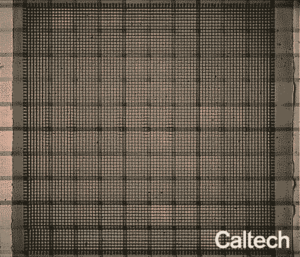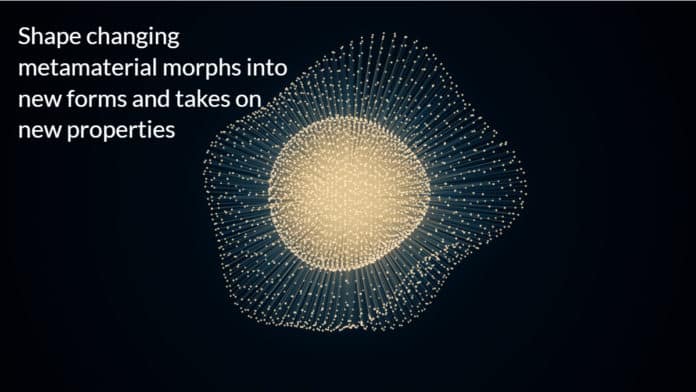Shape changing metamaterial morphs into new forms and takes on new properties
A newly developed type of architected metamaterial can change its shape in a flexible & tunable fashion.
While most reconfigurable metamaterials can toggle between 2 distinct states, the way a switch toggles on or off, the new metamaterial’s shape can be finely tuned, adjusting its physical properties as desired. This material, which has potential applications in next-generation energy storage and bio implantable microdevices, was developed by a joint Caltech-Georgia Tech-ETH Zurich research team in the lab of Julia R. Greer.
Greer, the Ruben F. and Donna Mettler, Professors of Materials Science, Mechanics and Medical Engineering in Caltech’s Division of Engineering and Applied Science, created these materials out of micro and nanoscale building blocks that are arranged into many sophisticated architectures that can be periodic, just like a lattice, or nonperiodic in a tailormade fashion, giving them many unusual physical properties.

And most materials that are designed to change their shape require a persistent external stimulus in order to change from one shape to another and stay that way: for example, they may be one shape when
wet and forms a different shape when just like a sponge that swells as it absorbs water.In contrast to this, the new nanometal material deforms through electrochemically driven silicon-lithium alloying reactions, meaning that it can be finely controlled to attain any states or shapes, remain in these configurations even upon the removal of the stimulus, and also be easily reversed. When applied a little current, the resulting chemical reaction changes the shape of the material by a controlled, small degree. when applied a lot of currents, the shape of the material changed substantially. When removed the electrical control, and the configuration is retained—just like tying off a balloon. A description of the new type of shape-changing metamaterial was published online by the journal Nature on September 11, yesterday.
Defects and imperfections exist in all material, and can also often determine a material’s properties. In the case of this metamaterial, the research team chose to take advantage of that fact as well as the build-in defects to imbue the material with the properties they wanted.
Xiaoxing Xia who is a graduate student at Caltech and lead author of the Nature paper said that the most intriguing part of this work to him is the critical role of defects in such dynamically responsive architected materials.
For the journal Nature paper, the research team designed a silicon-coated lattice with microscale straight beams which can bend into curves under electrochemical stimulation, that takes on unique mechanical and vibrational properties. Greer’s research team created these materials using an ultra-high-resolution 3-D printing process which is called two-photon lithography. By using this novel fabrication method, the team was able to build in defects in the architected nanomaterial system, based on a prearranged design. And in a test of the system, the research team fabricated a sheet of the metamaterial that, under electrical control, reveals a Caltech icon.
The study further showed that materials are just like people, it is the imperfections that make them interesting. Now Xiaoxing managed to first uncover the effects of different types of defects on these metamaterials and then used them to program a particular pattern that would emerge in response to an electrochemical stimulus, said Greer.
Material with a finely controllable ability to change its shapes has potential in future energy storage systems because this provides a pathway to create adaptive energy storage systems which would enable batteries, for example, to be significantly lighter as well as safer, and also to have substantially longer lives, Greer said. Some of the battery materials expand when storing energy, which creates a mechanical degradation due to stress from the repeated expanding and contracting. The architected materials like this shape-changing metamaterial can be designed to handle such structural transformations.
Claudio V. Di Leo who is an assistant professor of aerospace engineering at the Georgia Institute of Technology said that electrochemically active metamaterials provide a novel pathway for the development of next-generation smart batteries with both increased capacity as well as novel functionalities. At Georgia Tech, the team is developing the computational tools to predict this complex coupled electro-chemo-mechanical behavior, he added.
The Journal Nature paper is titled as “Electrochemically Reconfigurable Architected Materials.”
Author: Ria Roy

















































